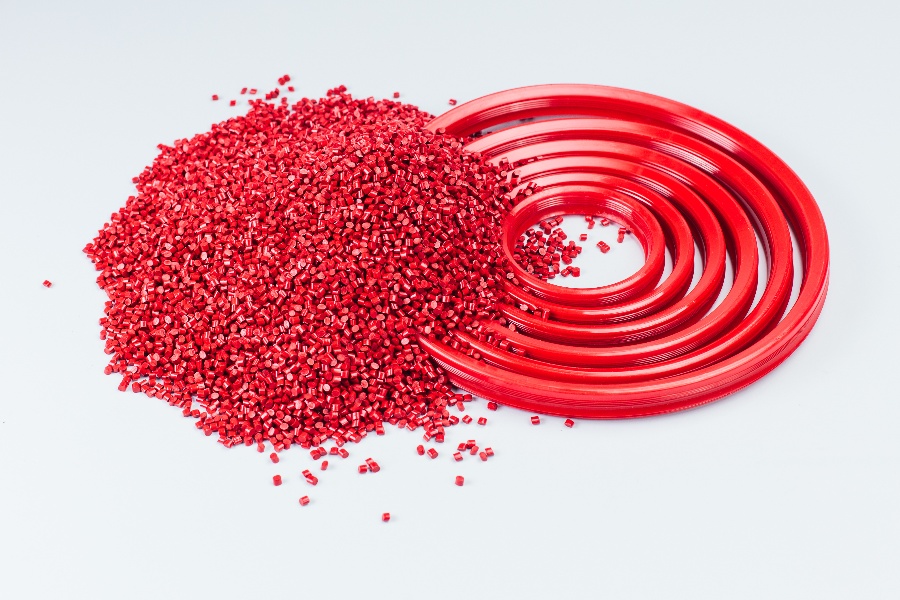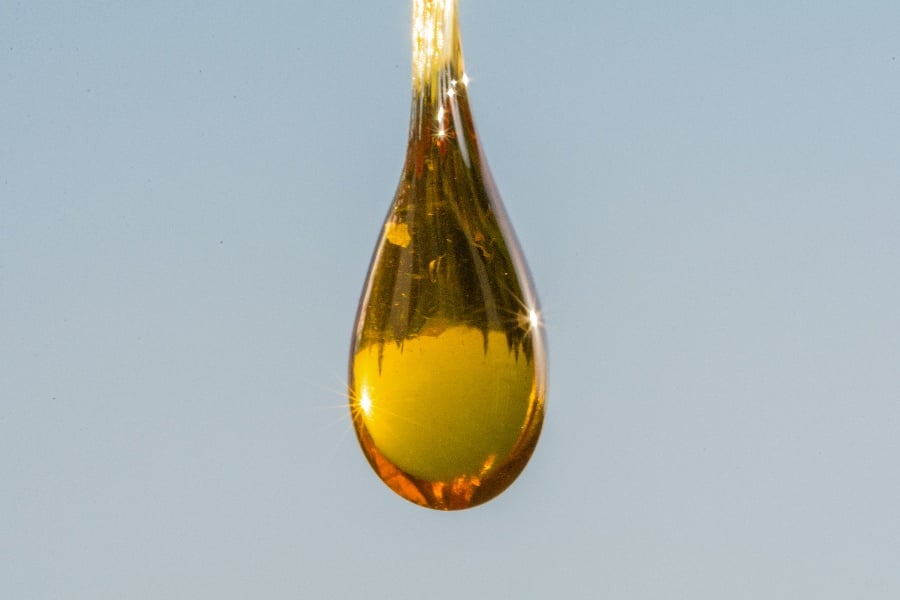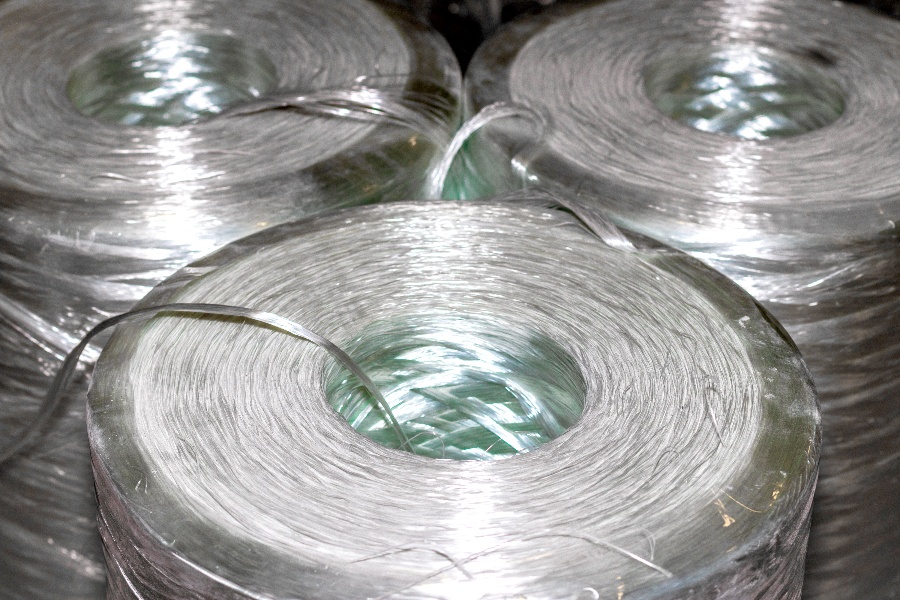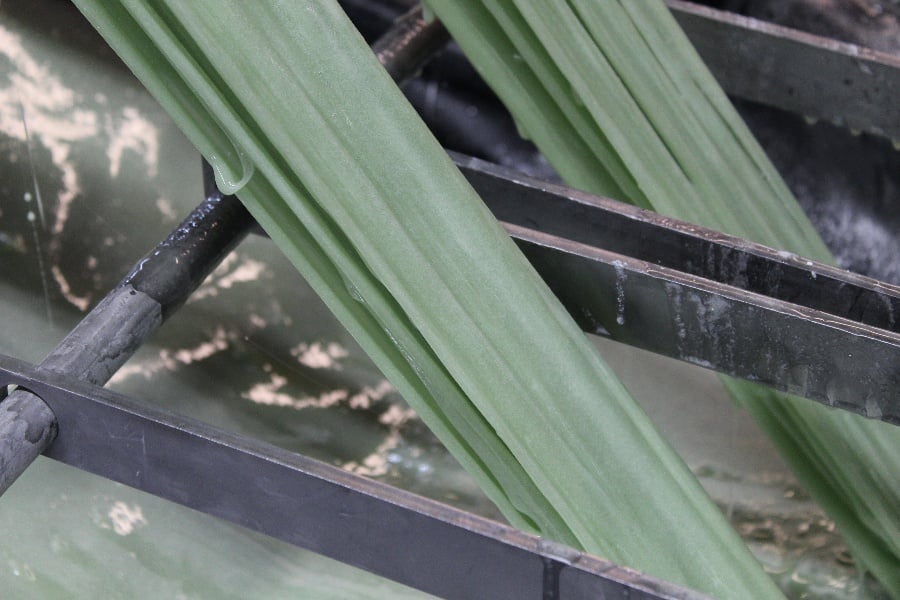
Fiber-reinforced plastics (FRPs) include a polymer matrix material and reinforcing materials like glass, carbon, and aramid fibers.
FRP products may be formed by pultrusion, a continuous process that begins with reinforcing fibers passing through guides. The guides help organize the fibers into the shape of the final product. The fibers are then impregnated with a matrix material (or resin), pulled through a die to be formed and cured, and cut to the desired length. The properties of the final product will vary depending on which resin is selected.
The resin acts as a binder holding the reinforcing fibers together and allows FRPs to be produced in a wide range of shapes and sizes. FRP matrix materials are classified as thermoplastics or thermosets. Thermosets are cured, leading to crosslinked polymer chains that result in rigid products. Thermoset products are advantageous in that, unlike thermoplastics, they don’t lose their structural rigidity or integrity when heated. Typical thermoset resins used in FRP pultrusion include epoxy, vinyl ester, phenolic, polyurethane, and unsaturated polyester.
Which Unsaturated Polyester is Right?
Selecting the right UP for your pultrusion project will depend on a number of factors. Some things to consider include operating temperature, corrosion resistance, availability, and cost. The two most common unsaturated polyesters used in FRP pultrusion are based on isophthalic acid or ortho-phthalic acid. Isophthalic is used in most pultrusions made in the US as Ortho-phthalic can be found in pultruded products made elsewhere.
UPs based on ortho-phthalic acid (also referred to as Ortho, Type O, or General Purpose) offers a moderate degree of corrosion resistance compared to other FRP resins. Type O resins have a maximum operating temperature of 212°F (or 100°C). This is due in part to the fact that sterically hindered phthalic acid is more hydrophilic than other isomers and forms less dense networks when cured, leading to increased sensitivity to hydrolytic degradation.
Isophthalic acid-based UP (also referred to as Iso or Type I) offers very good corrosion resistance and a maximum operating temperature of 221°F (or 105°C). The improved corrosion resistance and operating temperature of Type I UP are attributed to the more linear, higher molecular weight polymers formed from isophthalic acid. The improved corrosion resistance of Type I unsaturated polyester makes it the most commonly used resin category for corrosion-resistant structures like pipes, gasoline and chemical storage tanks, etc. Amoco reported that fuel storage tanks formed from Type I UP-based FRP showed no internal corrosion even after 25 years of service.
As expected, the cost of UP resin is tied directly to its performance capabilities. Type O polyester can be up to 25% less expensive per pound than Type I. The cost difference can be substantial, especially for larger projects. This illustrates the importance of knowing the operating environment in which pultruded parts will be used. Although the increased corrosion resistance and higher operating temperature of Type I polyester may be attractive, these properties may be unnecessary for certain applications.
Which Reinforcement Should You Choose?
Because they lack the mechanical properties required for many applications on their own, UPs are combined with reinforcing fibers to form FRPs. The fiber reinforcement provides increased strength, stiffness, and resistance against loading. Reinforced UP also exhibits improved chemical and environmental resistance as compared to unreinforced resin.
The two most common reinforcing materials used in pultruded FRPs are carbon and glass fibers. Carbon fiber has higher tensile strength than glass fiber, and also shows better fatigue and corrosion resistance. These improvements are balanced against brittleness and decreased impact strength and high electrical and thermal conductivity. Carbon fiber is also expensive to produce. The manufacturing process involves multiple heat treatment and post-treatment steps including carbonization and graphitization at temperatures of up to 3,000°C (or 5,432°F). Carbon fibehttps://app.hubspot.com/blog/5666396/edit-beta/78833556014/contentr-reinforced polyesters make up a relatively small share of the market. However, the carbon fiber market share is growing rapidly as advances in technology bring down the cost of these materials.
Glass fiber is the oldest type of reinforcing material used in pultrusion processes. Glass fibers are widely available at relatively low cost and offer a good balance of tensile and flexural strength, heat resistance, and corrosion resistance. Glass fibers also have excellent electrical properties compared to other reinforcement materials. Physical properties including modulus, tensile strength, flexural strength, and impact strength can be further improved by treating glass fibers with a silane to increase their interaction with the UP matrix. Examples of silane surface treating agents include amino silanes, glycidoxy silanes (which include epoxy functional groups), vinyl silanes, and methacryl silanes.
Another reinforcing fiber used in pultrusion applications is aramid, or aromatic polyamide. One common example of aramid fiber is Kevlar®. Unsaturated polyester-based FRPs reinforced with aramid fibers have a lower density and good fire resistance. However, aramid fibers have lower press sensitivity and are more susceptible to environmental degradation than glass or carbon fibers.
Unsaturated Polyesters in FRPs
Unsaturated polyester resins (UP) are used in pultrusion processes to fabricate products like solid rods, tubing, sheets, channels, and beams. These products are often used in the electrical, construction, transportation, and wind energy industries as load-bearing prefabricated components. They are also useful as thermal and insulation elements.
UPs are formed by the reaction of a carboxylic acid (or an acid derivative like an anhydride) and a hydroxyl-functional compound. At least one of the monomers must include a double bond or unsaturation. Here’s one example of a typical UP used in FRP pultrusion processes:
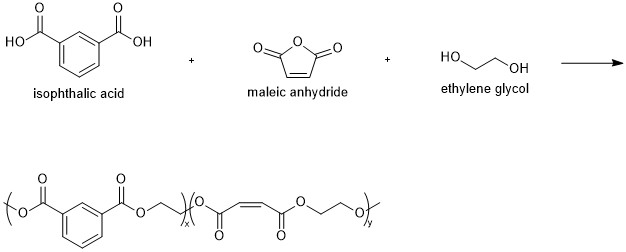
The resulting polyesters are combined with a reactive monomer like styrene or alpha-methylstyrene. The monomer has the effect of decreasing the viscosity of the polyester resin to more easily impregnate the reinforcing fibers during pultrusion. The monomer also reacts with the UP during curing to produce rigid crosslinked polymer chains. Here’s one example of styrene-crosslinked unsaturated polyester:
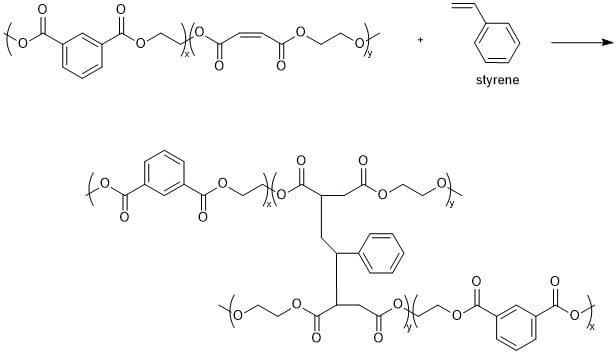
The UP in these examples is formed from isophthalic acid and ethylene glycol, with maleic anhydride contributing unsaturated groups to the polyester backbone.
Other typical monomers include phthalic (or ortho-phthalic) acid or anhydride, terephthalic acid, and adipic acid as dicarboxylic acids or anhydrides; diethylene glycol, triethylene glycol, and propylene glycol as hydroxyl-functional compounds; and maleic or fumaric acid as unsaturated monomers. Other commonly used crosslinking monomers include methyl methacrylate, para-methylstyrene, and diallyl phthalate. These can be used in combination with one another to optimize the properties of the final product.
Wrapping Things Up
Are you thinking about unsaturated polyester FRP in your next project? If so, get in touch with us today. The Tencom team can help select the right combination of resin system and fiber type to meet your design needs. And don’t forget - we are dedicated to custom fiberglass pultrusions using our newly added, state-of-the-art equipment.



